THE COWBOY ON THE CAPITOL GROUNDS VETS BRING TO LIFE BUFFALO SOLIDERS


THE COWBOY ON THE CAPITOL GROUNDS VETS BRING TO LIFE BUFFALO SOLIDERS

The lifelong bond of square dancing
With its compact size and split mode, ATTO is the only scooter that can fit in an airline’s overhead compartment.
Easily fits into car trunk
TSA-approved battery
12.5 mile range with max speed of 6 mph
Folds in seconds - without you bending down
Splits into two lightweight parts for easy lifting
Front and rear lights
Flat-free, shock-absorbing tires
Rolls like a suitcase in trolley mode



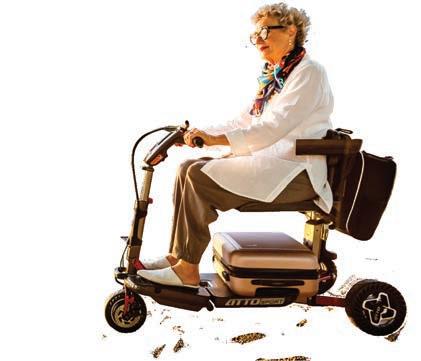

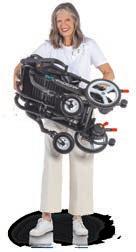
It easily fits into compact trunks, closets, and tight corners.
Ultra-Lightweight Carbon Fiber Design
Folds in seconds - without you bending down
Adjustable armrests for easy side entry
TSA-approved battery with 9.3 mile range
Joystick for right or left handed control
Pulls up comfortably to a table while seated
Flat-Free Wheels
At Movinglife, we make it simple to regain your freedom with free in-home demos and flexible payment plans tailored to fit your needs.
Trusted by over 60,000 users worldwide, our lightweight, stylish mobility solutions are designed to keep you active. With the industry’s best warranty, exceptional service, and personalized solutions, our products are sold in 62 countries and supported by a multilocation service network. Discover how Movinglife can help you embrace independence and enjoy life without limits.
I love the experience I'm having with my new ATTO SPORT. It's very convenient. Folds small enough to fit in the trunk of my car and still have room for more things. Gives me plenty of leg room which I need because of my height.
Donald J.
I got my new sport scooter right before going to Disney World with my family. Operating the scooter was easy and reliable. The ability to collapse it to take on the plane was another big plus. I’d definitely recommend it for travel.
Rhonda J.
Getting this scooter has changed my life. I’m able to enjoy the outdoors with my spouse, without struggling with tiring so easily. I get a lot of compliments and feel confident again. Thank you.
Albert D.

By
By Chris Burrows
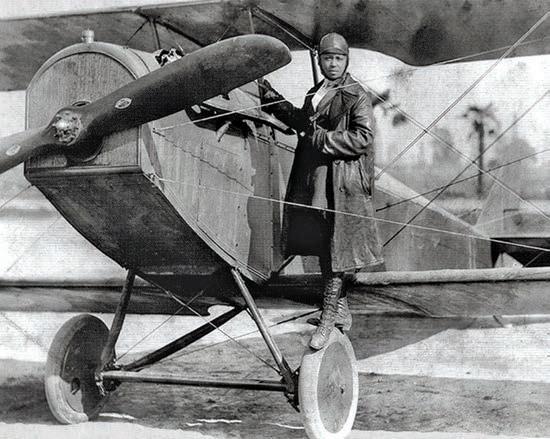
BESSIE COLEMAN, AN exhibition flyer and Waxahachie native, performed in her home state for the first time nearly 100 years ago—June 19, 1925, in Houston. Her greatest accomplishment came in 1921 in France when she became the first Black licensed pilot in the world. Check out Queen Bess Soared on our website to learn more about this aviation pioneer.

ENTER CONTESTS AT TEXASCOOPPOWER.COM
$500 RECIPE CONTEST Make it Spicy
FOCUS ON TEXAS PHOTOS
Family Vacation
RECOMMENDED READING
Ten years ago we also looked at sculptures. Download our February 2015 issue and read about Daddy-O Wade’s curious creations. Find it at TexasCoopPower.com/magazine-archives.
Tell us how you would finish that sentence. Email your short responses to letters@TexasCoopPower.com or comment on our Facebook post. Include your co-op and town.
“True peace is not merely the absence of tension; it is the presence of justice.”
—MARTIN LUTHER KING JR.
Lovers love Valentine’s Day. So do creditors. One study found that 1 in 3 people in relationships say they may take on credit card debt when shopping for their significant others this month. Among this group, about half won’t tell their partners about the debt.

Here are some of the responses to our December prompt: My favorite holiday lights are ...
The stars.
SUSIE LICON FARMERS EC FARMERSVILLE
In Johnson City at Pedernales Electric Cooperative and the courthouse.
SHELIA BETZEL UNITED COOPERATIVE SERVICES VENUS
Ones I don’t have to put up or take down. ED ROWLAND CECA CISCO
The ones reflected in my children’s eyes.
JESSICA PAXTOR
PEDERNALES EC LEANDER
Visit our website to see more responses.

My grandfather (Erwin Kresta) had a farm in El Campo with an orchard of orange and tangerine trees that were so productive he let people come and pick fresh fruits [Everybody’s Beeswax, December 2024].
Next to that he had over 50 beehives, and the bees would visit the fruit trees daily—fruit-infused natural honey. What I’d give to have some of Grandpa Kresta’s honey.
Ron Faldik
Bryan Texas Utilities Bryan
A Step in the Right Direction
I’m new to going to a lease with my husband, and after reading this, I will be sure to pack a compass [The Lease of Our Concerns, November 2024].
Rosie Strode Tri-County EC Cresson
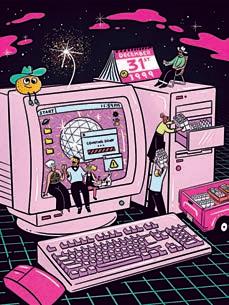
DECEMBER
2024
Field of Beams
“After seeing the magnificent, illuminated pecan in Bartonville, I had to share another illuminated beauty, on Montclair Drive in Colleyville.”
I remember very well in 1999 the news media blowing the whole Y2K issue completely out of proportion [Black-Eyed Peace, December 2024]. This was nothing less than fearmongering brought on by the computer industry to get everyone to purchase billions of dollars’ worth of new computers.
Glenn Arthur Rebber
Heart of Texas EC Valley Mills
You’ve given people like myself a huge compliment, and I’m glad you are so blissfully unknowing. I was one of thousands of software engineers working obscene hours ahead of the new year to keep the world running smoothly when the calendar flipped to the year 2000.
It was not a “supposed” glitch but very, very real.
Cindy Nichols
Magic Valley EC Weslaco
Editor, Texas Co-op Power 1122 Colorado St., 24th Floor Austin, TX 78701
Please include your electric co-op and town. Letters may be edited for clarity and length.
TEXAS ELECTRIC COOPERATIVES
BOARD OF DIRECTORS
Chair Avan Irani, Robstown
Vice Chair Bryan Wood, San Augustine
Secretary-Treasurer Cameron Smallwood, Burleson
Board Members Dale Ancell, Lubbock
Matt Bentke, Bastrop • Kerry Kelton, Navasota • Mark McClain, Roby
PRESIDENT/CEO Mike Williams, Austin
COMMUNICATIONS & MEMBER
SERVICES COMMITTEE
Mike Ables, Bellville • Kathi Calvert, Crockett
Marty Haught, Burleson • Tachi Hinojosa, Fredericksburg • Gary Miller, Bryan Zac Perkins, Hooker, Oklahoma • Bryan Story, Blossom • Buff Whitten, Eldorado
MAGAZINE STAFF
Vice President, Communications & Member Services Martin Bevins
Editor Chris Burrows
Associate Editor Tom Widlowski
Production Manager Karen Nejtek
Creative Manager Andy Doughty
Advertising Manager Elaine Sproull
Communications Specialist Samantha Bryant
Digital Media Specialist Caytlyn Calhoun
Senior Designer Stacy Coale
Assistant Production Manager Alex Dal Santo
Print Production Specialist Grace Fultz
Food Editor Vianney Rodriguez
Communications Specialist Erin Sinclair
Communications Specialist Claire Stevens
Proofreader Louie Bond
TEXAS CO-OP POWER Volume 81, Number 8 (USPS 540-560). Texas Co-op Power is published monthly by Texas Electric Cooperatives. Periodical postage paid at Austin, TX, and at additional offices. TEC is the statewide association representing 76 electric cooperatives. Texas Co-op Power’s website is TexasCoopPower.com. Call (512) 4540311 or email editor@TexasCoopPower.com.
SUBSCRIPTIONS Subscription price is $5.11 per year for individual members of subscribing cooperatives and is paid from equity accruing to the member. If you are not a member of a subscribing cooperative, you can purchase an annual subscription at the nonmember rate of $7.50. Co-op members: Please notify your co-op of address changes or other subscription requests.
POSTMASTER Send address changes to Texas Co-op Power (USPS 540-560), 1122 Colorado St., 24th Floor, Austin, TX 78701. Please enclose label from this copy of Texas Co-op Power showing old address and key numbers.
ADVERTISING Contact Elaine Sproull at (512) 486-6251 or esproull@texas-ec.org for information about purchasing display ad space in Texas Co-op Power and/or in our 26 sister publications in other states. Advertisements in Texas Co-op Power are paid solicitations. The publisher neither endorses nor guarantees in any manner any product or company included in this publication.
COPYRIGHT All content © 2025 Texas Electric Cooperatives Inc. All rights reserved. Reproduction of this issue or any portion of it is expressly prohibited without written permission. Willie Wiredhand © 2025 National Rural Electric Cooperative Association.

BY SAMANTHA BRYANT PHOTOS BY DAVE SHAFER
IT’S MID-JUNE, and the dance floor is hopping. Groups of eight dancers—two on each side of an imaginary square—turn, twirl, walk in time, and move in and out of a kaleidoscope of formations, skirts swirling and boots shuffling. A booming voice gives instructions over a loudspeaker: “Do-si-do, now promenade.”
One pair moves faster than the others in their square. Michael and Caroline Knight turn together and then Caroline takes an extra twirl before they start interweaving with the other three pairs.
“It’s style,” Caroline says. “It just makes it more fun. Like you can do dry, just do the moves as they are, but when you get really confident and you kind of have a muscle memory of what the moves feel like, then you start adding more spins and flair, and it just makes it fun.”
Among 272 dancers at the Brazos County Expo Complex in Bryan, Caroline, 26, and Michael, 33,

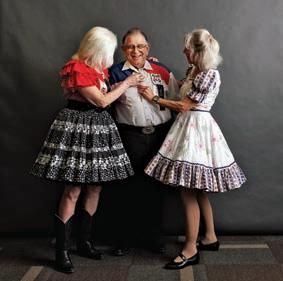

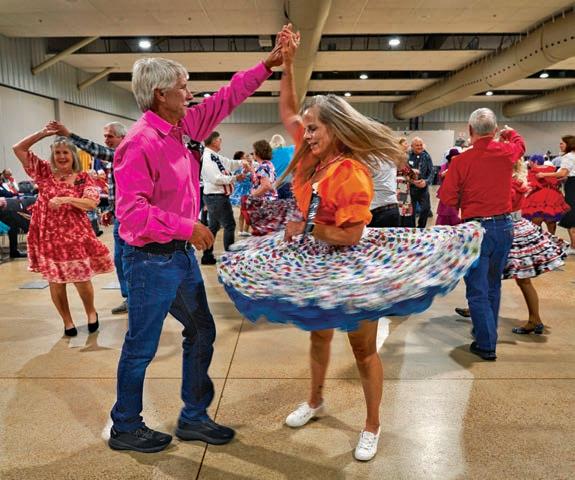
are among the youngest on the floor one night at the Texas State Federation Square and Round Dance Festival. The couple, customers of Bryan Texas Utilities, met while square dancing and, after attending the same club for six years, dated then eventually married in December 2024. They say the social aspect of square dancing—the state folk dance of Texas—is one reason they do it.
“It’s like two-stepping in that you kind of have a community and that you find friends doing it,” Caroline says, “but it’s more of a community because you’re not dancing with one person, you’re dancing with seven other people.”
Square dancing is not a spectator sport nor is it a competition—it’s about having fun and developing friendships, all in time to music. And as some dancers are aging out, a
passionate corps—and even some younger folks—are getting the word out about the physical, mental and social benefits of a pastime that’s still finding its rhythm.
The 450 attendees at the four-day state festival are just some of the 2,500 square dancers who belong to more than 100 clubs across the state. That’s a lot of dancers—but a lot fewer than there used to be.
OPPOSITE The swirl of skirts and smiles that is square dancing at the Brazos County Expo Complex in Bryan.
ABOVE, CLOCKWISE FROM TOP LEFT Portraits of lifelong friends Mary Whitaker, Lewis Chumbley and Janet Arnold. Andrew and Elizabeth Chu. Jeff and Karen Nelson go for a spin.

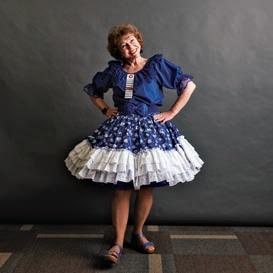



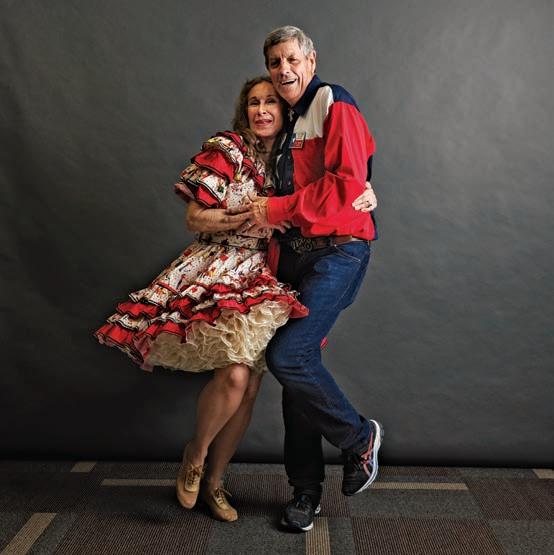
“You have to leave your troubles at the door because there’s not room for your troubles and concentrating on the dance.”
“Back in the ’70s and ’80s, the state dances would have 7,000 or 8,000 people at them, and the national dances would have 30,000 to 40,000,” says Matthew Whiteacre, former president of the statewide square dance organization.
“It’s down to 10% of that now.
“So in 50 years, we’ve lost 90% of our dancers.”
Whiteacre, a BTU customer, set the theme of the state festival in June: To Boldly Dance … Into the Future, which allowed for an element of science fiction and some conversation about the trajectory of square dancing.
The clubs sustain a tradition of modern Western square dancing, which has its roots in dances, like the French quadrille, that came over with European settlers to the American colonies but has evolved over the years as it

spread and mixed with other dance traditions, according to Smithsonian Magazine.
A component of square dancing that sets it apart from most other forms is the caller, a person who says, sings or chants the set of moves, known as calls, for dancers to follow. Callers can sing along with the song lyrics and sometimes use humor and rhymes as they guide the dancers. It can take years to master.
“I have to interweave the calls in with the lyrics, which that’s a skill all in itself,” says Scott Bennett, who has been a caller for over 40 years. “That’s the thing that keeps me attracted to square dancing all these years—it forces me to use lots of different aspects of entertainment.”
Historically, square dancing is done to traditional country songs that feature fiddles and banjos. And while folks still dance to that music, some callers, like Bennett, call to a mix of genres—classic rock, jazz and pop—anything with the right beat. Bennett says one of the more popular songs in recent years was Call Me Maybe by Carly Rae Jepsen.
“I’d put that on, and young folks would just be jumping through the ceiling they were so excited,” Bennett says.
OPPOSITE,
ABOVE Caller Vernon Jones of Springtown.
ANGEL: A higher-level dancer who helps beginners.
CALL: A set of moves that dancers perform when the announcer—the caller—says its name.
CALLER: The person who guides the dance by speaking or singing out the moves.
CORNER: The person on the other side of you who is not your partner (on your right if dancing the woman’s part, left if dancing the man’s).
CUER: The person guiding a round dance by telling dancers what steps to do.
PATTER: Calls that are spoken or chanted instead of sung.
ROUND DANCE: A choreographed ballroom dance for couples in which dancers follow a cuer and rotate around the dance floor.
TIP: A set of two square dances, generally consisting of a patter call followed by a singing call.
YELLOW ROCK: A hug between square dancers, particularly corners.
Dozens of calls are standardized through an international organization known as Callerlab. While some calls are fairly intuitive for dancers—such as circle left or forward and back—others have to be taught, such as flutterwheel, slip the clutch and box the gnat.
Most dancers take lessons and go through Callerlab’s Mainstream program, says John Kephart, president of the Texas State Callers’ Association. At this level, dancers learn 68 calls, but some have variations, equating to more than 130 total moves.
It sounds intimidating and may well stop some prospective participants, but any dancer will tell you to try it anyway, even if you have two left feet.
“If you can walk, you can square dance,” says Caroline Knight, who lives in Bryan and is a member of the Brazos Barn Dancers. “I’ve seen young kids—6, 7—that know how to dance really well. And then there’s people that are in their 90s that still dance.”
The activity provides exercise—a two-hour dance can equate to more than 5,000 steps and burns potentially hundreds of calories. Studies even show the dancing may stave off dementia. Jimette Smith started dancing around 1975, and she said another mental benefit is stress relief.
“In square dance, a caller can call anything to any music,” Smith says. “You have to listen—you can’t anticipate— because he can call anything. So you have to leave your troubles at the door because there’s not room for your troubles and concentrating on the dance.”
For 30 years, Smith owned a square dance apparel shop, Rhythm Creations, in Houston. She designed and sold the multicolored dresses, skirts, blouses and frilly petticoats that are worn during dances. Men typically wear long-sleeved Western shirts and bolo ties.
• There are square dance clubs in other countries, including Japan and Germany, but all the calls are done in English.
• The 75th National Square Dance Convention will be held in Waco in 2026, 20 years after the convention was last held in Texas—in San Antonio in 2006.
• There are camping square dance clubs.
• Former President Jimmy Carter and his wife, Rosalynn, hosted square dances on the White House lawn while he was in office.
• You can find a square dance club that offers classes in your area by visiting squaredancetx.com.

ABOVE Sue Blanchard twirls.
OPPOSITE, CLOCKWISE FROM TOP LEFT Portraits of Nora Creed-McClaskey, 11-year-old Lexi LeBlanc and grandmother Lea Ann McGee, 12-year-old best friends Caroline Einkauf and Meg Rhinehart, Tim and Tam Austin, Jan Albers, and Linda and Don Prendercast.
In recent years, some clubs have relaxed the dress code requirements—one of several ways square dance clubs are trying to attract more participants, including updating music and programs, while preserving the traditions and community that have attracted so many.
Square dancing in clubs became popular after World War II, according to the International Encyclopedia of Dance, but participation has declined in recent years as dancers age out and young people enjoy a plethora of options for socializing and burning calories. The pandemic also dealt a blow as dancers dropped out while clubs paused their activities.
Some clubs have incorporated a Callerlab program called Social Square Dancing, released in 2021. It has a shorter training period to appeal to new dancers. The organization also is pushing to streamline some of its other programs.
In an age when people can feel more isolated than ever, the community and connection square dancing provides are enticing new participants. The family-friendly nature of the activity—there’s no drinking or smoking allowed— enables multigenerational participation.
“Everybody here is part of what we call our square dance family,” says Claudia Lester. She and her husband, Gary, found a community of unmatched camaraderie when they started dancing 15 years ago.
Some clubs are seeing an increase in numbers. Audrey Mansell, former president of the North Texas Square and Round Dance Association and a Tri-County Electric Cooperative member, said they’ve seen growth in their 26 clubs for the first time in 13 years, which she attributes to members intentionally inviting friends to join and adopting a relaxed dress code.
Ben Vinson, a freshman at Texas A&M University, danced in high school with the H-Town Squares, a club for teens and young adults in Houston geared toward homeschooled students. The club boasts 110 dancers, making it one of the largest in the state.
Vinson says the friendships he forged made the challenge
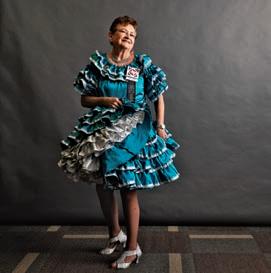


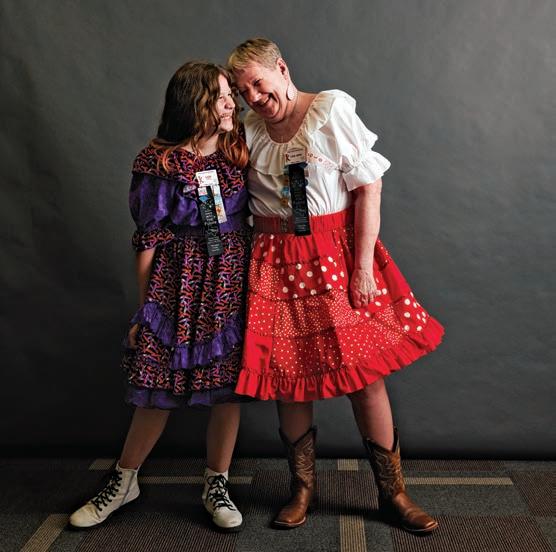
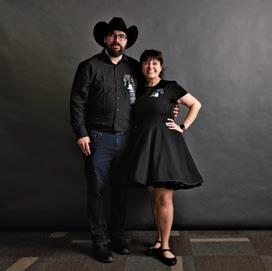
of learning the complicated moves worth his while.
“I do it mainly for the fellowship,” he says, “but it’s still a cool skill to have.”
Caroline Knight also got into square dancing as a teenager when friends invited her to join them, though at first she was skeptical.
“I thought it was going to be super folky and corny, and I was like, ‘I don’t know if I’ll like it, but I want to hang out with you so I’ll give it a try,’ ” Knight says. “And it is so much fun, especially when you’re dancing with people that are really excited about it.”
Once a dancer is hooked, they may be in for life. Charles Spoon, president of the Lubbock Area Square and Round Dance Federation, encourages anyone who’s curious about

square dancing to try it. The 81-year-old is on the dance floor about 150 nights out of the year and went to his first dance when his then-girlfriend Ellen, now his wife, asked him to give it a shot.
“She said, ‘Just try it one time. If you don’t like it, you don’t have to go,’ and I said, ‘OK,’ ” says Spoon, a member of South Plains Electric Cooperative. “So I tried it. That was back in 1968.
“And I’m still doing it.” D
Watch the video on our website and discover how square dancing is great exercise and an easy way to make new friends.
A New Yorker in Paris captured Texas and the West in an iconic statue
BY CHRIS BURROWS
There’s a 15-foot-tall, 100-year-old mystery on the campus of the University of North Texas in Denton. In a tree-shaded area near the general academic building, a regal bronze sculpture of artist Diego Velázquez on horseback overlooks students and staff as they go about their days.
New Yorker Constance Whitney Warren sculpted Velázquez, a 17th-century painter, when she was living in Paris after World War I. The family of billionaire Harlan Crow donated the piece to UNT in 1994.
Nobody seems to know why.
“I do not have the answers,” says Holly Hutzell, art registrar for the university. “We do not have a record as to why the donor gifted it to UNT. Nor do we know why the artist depicted the Spanish master on horseback.”
But 200 miles north and south of Denton, up and down Interstate 35, iconic Western statues by Warren on the grounds of the capitols of Texas and Oklahoma need no explaining. Both bronzes depict life-size wooly-chapped cowboys astride broncos rearing back over cactuses. Along the path of the former Chisholm Trail, these century-old works could not be more at home. Right?
It was 100 years ago—January 19, 1925—that The Austin Statesman reported several thousand Austinites, visitors and lawmakers gathered at the Capitol and watched as two men dressed in cowboy garb pulled a white sheet from the newly christened Texas Cowboy Monument—a “tribute to the rough and romantic riders of the range,” reads a weather-worn plaque at its base.
It was the day before Texas’ first female governor, Miriam A. “Ma” Ferguson, was sworn into office, and crowds were swarming in anticipation.
“There is not another place where the statue of a cowboy can with such fitness and such propriety be placed,” said a representative of the sculptor’s family, Charles Cason, at the unveiling. “Texas was the cowboy’s home, and the very name

‘cowboy’ brings to every American’s mind the name of Texas with all her glorious traditions and romance of the endless ranges.”
Warren was born in 1888 to an affluent New York family, and despite a weekslong honeymoon through the American West after her marriage to a French count, in 1912, there’s no evidence that she ever set foot in Texas.
“At an early age, she gained a fascination for the West from stories told by her father of his experiences as a mining engineer on the frontier,” writes An Encyclopedia of Women Artists of the American West. Warren moved to France after the honeymoon, and when World War I broke out, she chauffeured English officers.
After the war, she poured herself into sculpture, executing


No one has done more to unravel the mystery of Warren than Sullivan, former professor of art history at UNT and later dean of Texas Christian University’s College of Fine Arts.
Cowboy No. 2 was shipped to New York from Paris several months before the dedication in Austin.
It wasn’t long before Oklahoma decided it needed a Warren bronco. Its Tribute to Range Riders, installed in 1928, was that capitol’s first art piece.
Warren and the count divorced in 1922, she returned to the U.S. a few years later and in 1930, she committed herself to Craig House, a discreet asylum in upstate New York. Almost nothing is known of Warren’s later years. She died in 1948.
After UNT received the Velázquez piece in the 1990s, Sullivan went to work solving its mysteries.
some 100 pieces—mostly horses—between 1920 and 1930.
“A sharp observer of anatomy and a vigorous modeler, she was at her best with figures in violent action,” Stuart Preston of The New York Times wrote in 1953.
Among those works was Warren’s Cowboy No. 2, sculpted in 1921. It was exhibited at the 1923 Paris Salon, a premier annual art exhibition, and missed a bronze medal by two votes, instead claiming an honorable mention.
“This was prestigious recognition for an American woman artist,” wrote the late Scott Sullivan. “The Cowboy was praised in the French press and highly popular in Paris. Cason told Gov. [Pat] Neff that the artist wished to donate the bronze to a western state. The governor agreed to accept it on behalf of Texas.”
He made contact with some members of Warren’s family in Massachusetts, and during the course of his research that formed the basis of a 3,000-word article published by the Gilcrease Journal in 2015, he discovered that a sculpture of Velázquez by French artist Emmanuel Frémiet was installed at the Louvre from 1893 to 1933, likely inspiring Warren’s Velázquez in Denton.
Sullivan’s research brought much-deserved detail to Warren’s life. She was among few female sculptors of the early 20th century with the skills, means or ambition to produce art that typified the American frontier. She was a pioneer accepted by pioneers of another sort.
“Warren deserves greater recognition for her work,” Sullivan wrote, “and for her willingness to follow her imagination into a male-oriented and male-dominated arena largely unexplored at the time by female artists.” D
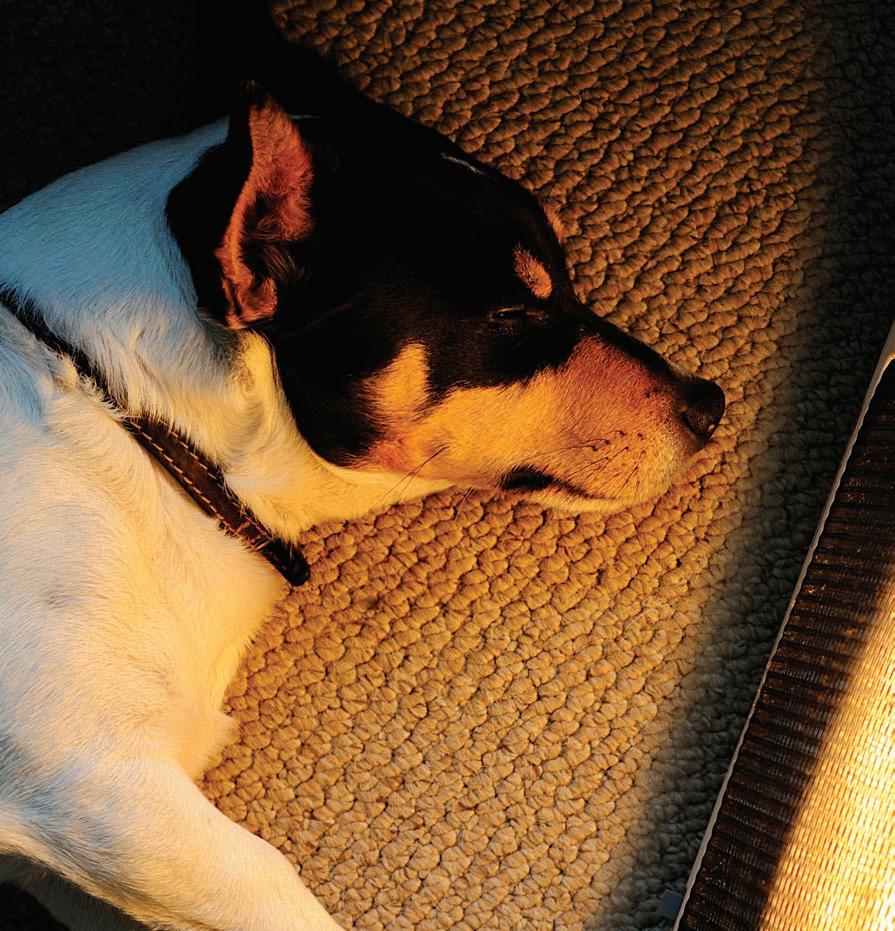
Space heaters are meant to provide supplemental heat, not replace your home’s heating system. If used incorrectly, space heaters can pose fire and burn risks.
When using your portable heater, heed these rules:
Read and follow the manufacturer’s warnings and the operation and care guidelines before using a space heater.
Space heaters need space. Keep them at least 3 feet away from any combustible materials such as bedding, drapes and furniture.
Never use space heaters around unsupervised children or pets.
Always turn the heater off and unplug it when leaving the room or going to sleep.
Plug space heaters directly into an outlet; do not use an extension cord.
Your electric cooperative encourages you to always practice safety.


..I express my gratitude to each of you. Your trust and support fuel our passion for serving our members.
AS WE STEP INTO February, the month of love, it’s the perfect time to reflect on what makes NEC Co-op Energy so special. Our cooperative isn’t just about delivering electricity; it’s about powering our communities, fostering connections, and making a difference together.
Here are a few reasons to fall in love with your co-op all over again:
1. You Are More Than a Customer – You’re a Member-Owner: You’re not just a consumer; you’re a vital part of what we do. As a memberowner, you have a voice in the decisions that shape the future of your co-op. From electing board members to voting on important issues, your input matters. It’s a relationship built on mutual trust and accountability.
2. We’re Rooted in the Community: Unlike other retail electric providers, NEC Co-op Energy is owned by the people we serve. Our team lives and works right here, sharing your values and priorities. Whether it’s supporting local charities, volunteering at events, or sponsoring educational programs, we’re deeply committed to enriching our community’s quality of life.
3. Giving Back Is in Our DNA: Through programs like capital credit refunds, we share our financial success with our members. In 2024 alone, we returned
over $5 million to our members. That’s not just money saved; it’s a reflection of our commitment to putting you first.
4. Innovation for a Brighter Future: We’re always looking ahead to bring you safe, reliable, and affordable energy. From offering flexible payment options to exploring renewable energy solutions, NEC Co-op Energy is dedicated to meeting the evolving needs of our members while maintaining a strong, sustainable future.
5. Empowering Members Every Step of the Way: Education is a cornerstone of our mission. From energy efficiency and safety tips to our annual Save A Watt event, we’re here to help you make informed decisions about your energy use. Our goal is to empower you with knowledge that makes a difference in your everyday life.
This Valentine’s season, I express my gratitude to each of you. Your trust and support fuel our passion for serving our members. Together, we’re more than a co-op; we’re a family. Our doors are open, and we welcome your thoughts, feedback, and ideas. Let’s continue to grow, innovate, and strengthen our community together.
Here’s to loving your co-op and everything we achieve as one.

Varzavand "Avan" Irani Chief Executive Officer
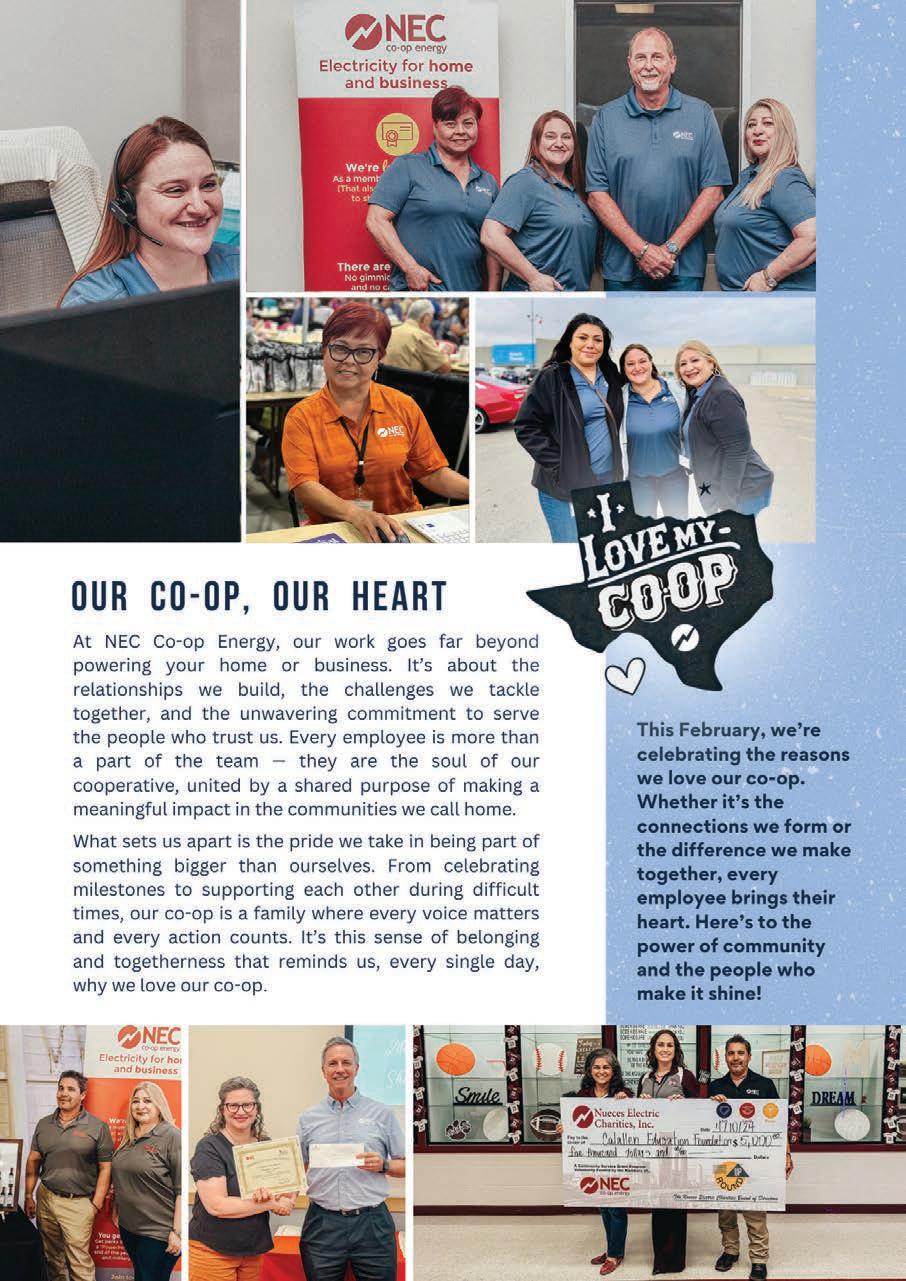

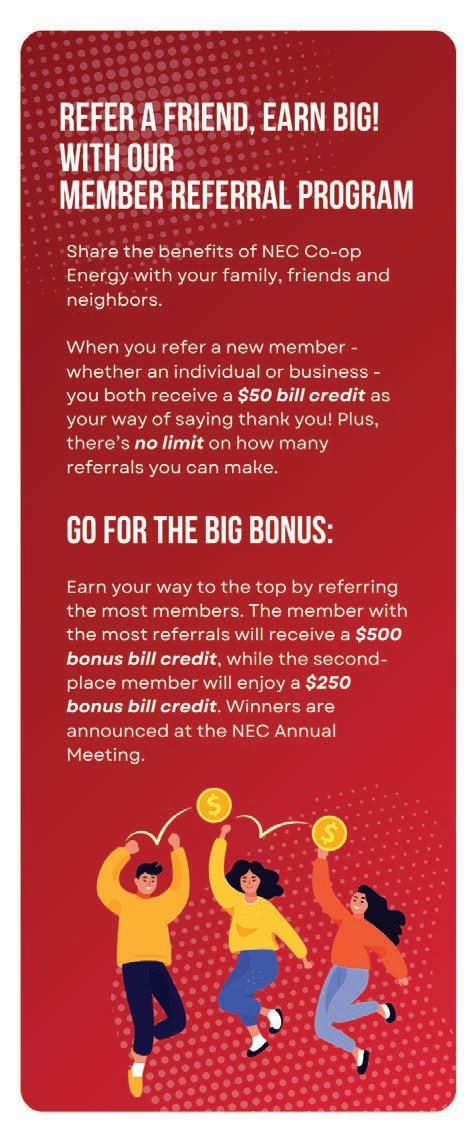



1. Power Provider
NEC Co-op Energy is your Retail Electric Provider (REP). We provide at-cost electric service for homes or businesses.
2. Energy Charges consist of a Base Charge, Energy Charge, and any opt-in NEC Co-op Energy programs such as the HALO-Flight Guardian Program or Operation RoundUp. Base Charge is the cost of creating bills and other administrative services. The Energy Charge is the at-cost charge for energy consumption. Most REP's list the Current and TDU PassThrough Charges as separate line-items.
3. TDU Pass-Through Charges is the cost of your Transmission and Distribution Utility to cover costs for poles, wires, transformers, kWh usage, metering, reporting and other services.
4. Assessments & Taxes consist of PUC assessment, gross receipt assessment, and commercial sales tax charges (if applicable).
5. kWh Usage History chart on your bill includes your current energy usage history for the past 13-months.
6. Outages/Emergencies
NEC Co-op Energy does not maintain your power lines. To report an outage, contact your TDU power delivery (wires) company directly.
7. PowerPerks adjustments and Capital Credit retirements will be reflected here on your November or December electric bill.




WHEN TEMPERATURES DROP, electricity use increases. That’s because heating systems run longer and harder to keep us comfortable while we’re doing more activities inside. Factor in that we all tend to use electricity at the same times—in the morning and early evenings—and that equals a lot of strain on our electric grid.
In winter months, when even more electricity is being used simultaneously across the country, it’s possible for electricity demand to exceed supply, especially if an unexpected event like a sudden ice storm occurs. If this happens, which is rare, the grid operator for our region of the country may call for rolling power outages to relieve strain on the grid.
To help keep the heat on for you, your family and neighbors, here are a few things you can do to relieve pressure on the grid (and save a little money along the way).
• Select the lowest comfortable thermostat setting and turn it down several degrees whenever possible. Your heating system must run longer to make up a greater difference between the temperature setting and the outdoor temperature.
• Seal air leaks around windows and exterior doors with caulk and weatherstripping. Air leaks and drafts force your heating system to work harder than necessary.
• Stagger your use of major appliances such as dishwashers, ovens and dryers. Start the dishwasher before you go to bed and use smaller countertop appliances like slow cookers and air fryers to save energy.
• Ensure that your heating system is optimized for efficiency with regular maintenance and proper insulation. Make sure your furnace filter isn’t clogged or dirty. Replace it as needed. When possible, use cold water to reduce water heating costs. Setting your water heater thermostat to 120 degrees can help you save energy and reduce mineral buildup and corrosion in the water heater and pipes.
• Unplug devices when not in use to eliminate unnecessary energy use. Even when turned off, electronics in standby mode consume energy.
• Plug devices into a power strip so you can turn them all off atonce with the push of a button.
As we face the challenges posed by winter weather, understanding its impact on energy demand is crucial for maintaining a reliable power supply. By adopting energy conservation practices during periods of extreme cold, not only can you save money on your electric bills, but you can also contribute to the resilience of the power grid, keeping our local community warm and connected.

Here are five ways to celebrate Valentine’s Day with a special dinner that’s both romantic and energy saving.
1. Whip up a feast in the slow cooker or air fryer, using far less energy than your stovetop or oven. A bonus: There's only one pot to wash after dinner.
2. Unplug your phones, the TV, and other electronic devices for some quality one on one time.
3. Eat dinner by candlelight. Turn off the overhead lights and lamps— or at least most of them. A candlelit dinner is romantic and saves energy.
4. Pack leftovers for the refrigerator but let them sit on the counter to cool down for a little while. Placing hot food in the fridge can heat up the appliance and make it work harder to stay cold.
5. If spoiling your valentine with gifts of gadgets, consider those that are powered with batteries rather than electricity. Or stick to classic Valentine’s Day gifts like teddy bears, chocolate and flowers.




February is a month to focus on what’s close to your heart—your loved ones and their safety. At NEC, we’re here to help keep your home hazard-free with some practical electrical safety tips.
• Check Your Outlets: Warm or discolored outlets can signal an issue. Stop using them and consult a professional.
• Use Proper Extension Cords: Only use extension cords rated for the devices they’re powering. Avoid using them as permanent solutions.
• Placement Matters: Keep space heaters at least three feet away from flammable items like curtains or bedding.
• Unplug When Not in Use: Unplug space heaters when you leave the room or go to sleep.
• Have an Emergency Plan: Make sure your family knows where flashlights and batteries are stored in case of outages.
By taking these precautions, you’re not just protecting your home—you’re safeguarding the people who matter most. This February, let’s commit to safety and peace of mind together.
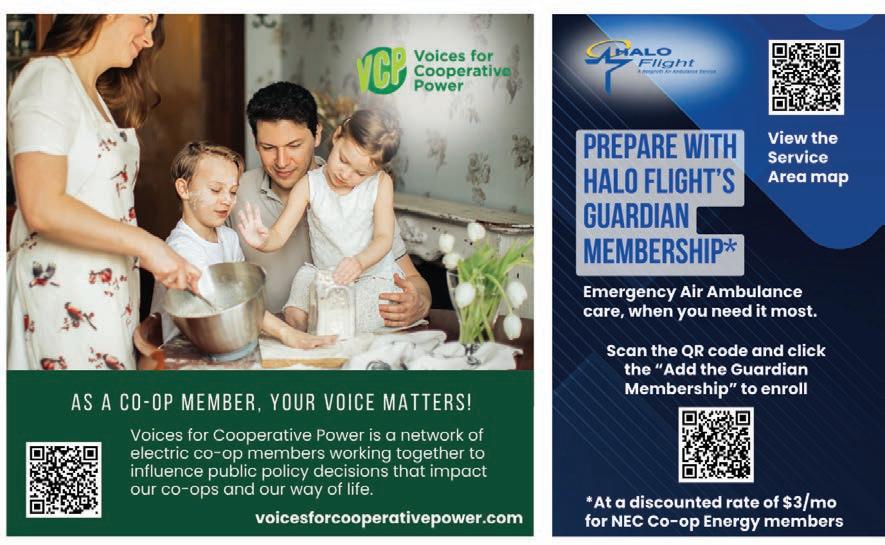






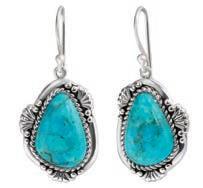
Centuries ago, Persians, Tibetans and Mayans considered turquoise a gemstone of the heavens, believing the striking blue stones were sacred pieces of sky. Today, the rarest and most valuable turquoise is found in the American Southwest–– but the future of the blue beauty is unclear.
On a recent trip to Tucson, we spoke with fourth generation turquoise traders who explained that less than five percent of turquoise mined worldwide can be set into jewelry and only about twenty mines in the Southwest supply gem-quality turquoise. Once a thriving industry, many Southwest mines have run dry and are now closed.
We found a limited supply of turquoise from Arizona and purchased it for our Sedona Turquoise Collection. Inspired by the work of those ancient craftsmen and designed to showcase the exceptional blue stone, each stabilized vibrant cabochon features a unique, one-of-a-kind matrix surrounded in Bali metalwork. You could drop over $1,200 on a turquoise pendant, or you could secure 26 carats of genuine Arizona turquoise for just $99
Your satisfaction is 100% guaranteed. If you aren’t completely happy with your purchase, send it back within 30 days for a complete refund of the item price.
The supply of Arizona turquoise is limited, don’t miss your chance to own the Southwest’s brilliant blue treasure. Call today!
Jewelry Specifications:
• Arizona turquoise • Silver-finished settings
Sedona Turquoise Collection
A. Pendant (26 cts)
$299 * $99 +s&p Save $200
B. 18" Bali Naga woven sterling silver chain $149 +s&p
C. 1 1/2" Earrings (10 ctw)
Complete Set**
$299 * $99 +s&p Save $200
$747 * $249 +s&p Save $498
**Complete set includes pendant, chain and earrings.
Call now and mention the offer code to receive your collection.
1-800-333-2045
Offer Code STC946-09
You must use the offer code to get our special price.



Reenactors go to great lengths to share the important story of buffalo soldiers
BY MARTHA DEERINGER • PHOTO BY KENNY BRAUN
IT WAS A tight squeeze for Michael Brown, wedging his large frame into a small picnic table for a children’s tea party at Mother Neff State Park, outside Waco. Donning a plastic necklace over his uniform and handling tiny cups, dainty canapés and tea cakes, he charmed the socks off the children and parents clustered around the tables at an annual park event.
As a buffalo soldier reenactor, these experiences bring him joy.
About 150 years earlier, in 1866, Congress created six all-Black Army regiments—later consolidated to four—that became known as the buffalo soldiers. Their main charge was to support the nation’s westward expansion, build roads and other infrastructure, protect settlers,
and guard postal routes throughout the Southwest and Great Plains.
That expansion often put the soldiers, some posted at forts in Texas, in direct violent conflict with the Native American tribes whose lands were being seized.
Originally commanded by white officers, the buffalo soldiers, numbering more than 40,000 in total, often faced extreme racism over 85 years of service. The last Black regiment was disbanded in 1951.
Differing accounts explain the buffalo soldier name. One is that Native Americans called the soldiers that because of their fierce fighting. Another is that Native people thought the soldiers’ dark hair resembled buffalo fur. Still another says the name came from the buffalo-hide
coats the troops wore in cold weather.
The buffalo soldiers persevered through extreme weather; infectious diseases with little access to treatment; and rough, unfamiliar terrain. But in many cases, it was the first opportunity for formerly enslaved men (and at least one woman) to work as professional soldiers and be paid the same $13 monthly salary that white soldiers received.
All these years later, reenactors like Brown keep the important story of the buffalo soldiers alive. The all-volunteer Bexar County Buffalo Soldiers Association in San Antonio to which he belongs provides speakers for youth groups, schools, churches, trail rides and other historical events.
“Each of our 40 active members portrays one of the original soldiers from the 19th century,” Brown says. “All are Army and Air Force veterans.”
Brown was deployed with the Army 2005–06 in Afghanistan. As a buffalo soldier, he represents Sgt. Thomas Boyne, who received the Medal of Honor—the U.S. armed forces’ highest distinction— in 1882. All told, 18 African American soldiers earned a Medal of Honor during the American Indian Wars.
Brown, pictured left, who serves on the board for the group of reenactors, wears an 1874 Army field campaign uniform with a dark blue wool sack coat and sky-blue woolen pants, heavy enough to make a brave man melt into a puddle in the heat of a Texas summer.
It’s worth the work for him.
“I especially love the educational portion of the program,” Brown says. “We explain to the audience how the soldiers’ past was tied into slavery and the honor of becoming the first professional soldiers. And for me, it’s all about the kids.”
The reenactors tell a broader story of what life was like on the frontier in Texas. While theirs is a serious mission, they make learning fun, including occasionally sitting down with a group of children to share tiny cups of tea. D
firefighters
BY VIANNEY RODRIGUEZ, FOOD EDITOR
Pan de campo, aka camp bread or cowboy bread, originated with the vaqueros of South Texas. My abuelita made it in a cast-iron skillet and enjoyed it with a steaming cup of coffee. It’s a flatbread that resembles a thicker, flatter biscuit with a crispy outside and soft, chewy interior.

STRAWBERRY BUTTER
1 cup (2 sticks) butter, softened 2 tablespoons powdered sugar ½ cup diced strawberries
PAN DE CAMPO
2 cups flour, plus more for dusting
2 teaspoons baking powder
2 teaspoons salt
10 tablespoons solid vegetable shortening, divided use
¾ cup milk
1. STRAWBERRY BUTTER In a medium bowl, beat butter with an electric mixer on medium speed until smooth and creamy.
2. Add powdered sugar and mix until well combined. Stir in strawberries. Cover and refrigerate at least 1 hour or overnight before serving.
3. PAN DE CAMPO Preheat oven to 425 degrees. In a large bowl, whisk together flour, baking powder and salt.
4. Add 8 tablespoons shortening and use a pastry cutter or two forks to cut the shortening into the flour until the mixture resembles pea-sized coarse crumbs. Add milk, stirring just until dough forms.
5. Turn dough onto lightly floured surface. Knead gently until dough comes together to form a ball. Using a lightly floured rolling pin, roll dough into a ½-inch-thick circle.
6. Grease a 10-inch skillet with remaining 2 tablespoons shortening, then place in oven for 5 minutes to heat through.
Remove from oven, carefully place dough into skillet and return to oven. Bake 10 minutes, then flip bread and bake an additional 5 minutes.
7. Slice and serve topped with strawberry butter.
SE RVES 8
Follow Vianney Rodriguez as she cooks in Cocina Gris at sweetlifebake.com, where she features a recipe for Banana Bread with Cajeta Cream Cheese Frosting.

DENNIS BAUM
GRAYSON-COLLIN EC
When Baum was a cook at a fire station, he made these soft, fluffy rolls, which have a rich, buttery taste, daily for the crew. This easy recipe comes together quickly, delivering rolls baked to golden perfection that pair well with any dish.
1 packet active dry yeast (0.25 ounces)
1 cup warm water, roughly 110 degrees
2½ tablespoons sugar
2½ cups flour, plus more for dusting
½ teaspoon salt
1½ tablespoons solid vegetable shortening
1. Coat an 8-inch round pan with cooking spray or butter.
2. In a large bowl, whisk yeast in warm water. Let the mixture stand 5 minutes. Add sugar, flour, salt and shortening, stirring until well combined.
3. Turn dough out onto a lightly floured surface and knead about 1 minute. Divide and form into 12 balls. Place into prepared pan and cover with a towel.
4. Place in a warm area and allow to rise about 1 hour. Preheat oven to 400 degrees.
5. Bake 20 minutes or until tops are lightly browned.
MAKES 1 DOZEN ROLLS
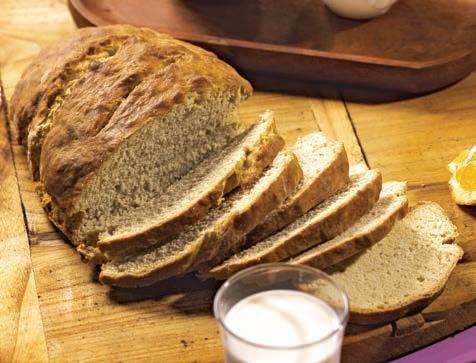
CINDY HANDY GRAYSON-COLLIN EC

This is perfect for new bakers. It’s quick and easy, requiring no rising time or fancy techniques. Made with simple ingredients, this bread delivers a satisfying, golden crust with a soft, flavorful interior. Whether you’re short on time or just starting out, this noyeast option ensures delicious, homemade bread in no time!
1½ cups water
2 teaspoons distilled white vinegar
4 cups flour, plus more for dusting
1 teaspoon salt
1 teaspoon sugar
2 teaspoons baking powder
2 teaspoons baking soda
1 tablespoon (1/8 stick) butter, softened
1. Preheat oven to 375 degrees. Line a baking sheet with parchment paper.
2. In a small bowl, stir together water and vinegar. In a large bowl, whisk together flour, salt, sugar, baking powder and baking soda. Add vinegar mixture to dry ingredients and stir to mix well.
3. Turn dough out onto a lightly floured surface and knead about 1 minute, sprinkling additional flour on the surface as needed to prevent sticking.
4. Shape the dough into an oval loaf. Place it on the prepared baking sheet and cut 3 diagonal slits across the top of loaf.
5. Bake 30–35 minutes. Remove from oven and brush with butter. Allow to cool 5 minutes, then slice and serve warm.
SERVES 4
MAKE IT SPICY DUE FEBRUARY 10
CONTINUED ON PAGE 28 >
We’re turning up the heat in our July issue, and we need your help. Send us your tastiest spicy recipes for a chance to win $500. Enter by February 10.
UPCOMING: BEEFY BURGERS DUE MARCH 10
RITA
HUIE
UNITED COOPERATIVE SERVICES
This delightful treat brings together the rich, velvety taste of chocolate with the bright, citrusy notes of orange. The buttery texture makes each bite soft and indulgent, perfect for breakfast or dessert. This is a must-try for those who love the classic combination of chocolate and citrus.
½ cup (1 stick) butter, softened, plus more for greasing the pan
2½ cups flour
1 teaspoon baking powder
1 teaspoon baking soda
1 teaspoon salt
1 teaspoon orange zest
¼ cup dark cocoa powder
¼ cup brown sugar
1 egg, beaten
¾ cup buttermilk
1 teaspoon orange extract

2 tablespoons orange juice concentrate, undiluted
2 tablespoons orange liqueur or 2 additional tablespoons orange juice concentrate Orange marmalade, for serving
1. Preheat oven to 350 degrees. Grease a loaf pan with butter.
2. In a large bowl, stir together flour, baking powder, baking soda, salt, orange zest, cocoa powder and brown sugar.
3. In a medium bowl, stir together egg, buttermilk, orange extract, orange juice concentrate, liqueur and ½ cup butter until smooth.
4. Make a well in dry ingredients, add wet ingredients and stir well. The batter will be thick.
5. Spread the batter into prepared loaf pan. Bake 35–40 minutes or until a toothpick inserted comes out clean.
6. Remove pan from oven and allow to cool 15 minutes. Run a knife around edges of bread, and carefully remove from pan.
7. Slice and serve with orange marmalade.
SERVES 8
•
•
$100,000.00







Not only are these hefty bars one full Troy ounce of real, .999 precious silver, they’re also beautiful, featuring the crisp image of a Morgan Silver Dollar struck onto the surface. That collectible image adds interest and makes these Silver Bars even more desirable. Minted in the U.S.A. from shimmering American silver, these one-ounce 99.9% fine silver bars are a great alternative to one-ounce silver coins or rounds. Plus, they offer great savings compared to other bullion options like one-ounce sovereign silver coins. Take advantage of our special offer for new customers only and save $10.00 off our regular prices.
What makes them iconic? The Morgan Silver Dollar is the legendary coin that built the Wild West. It exemplifies the American spirit like few other coins, and was created using silver mined from the famous Comstock Lode in Nevada. In fact, when travelers approached the mountains around the boomtown of Virginia City, Nevada in the 1850s, they were startled to see the hills shining in the sunlight like a mirror. A mirage caused by weary eyes?



No, rather the effect came from tiny flecks of silver glinting in the sun.















While no one can predict the future value of silver in an uncertain economy, many Americans are rushing to get their hands on as much silver as possible, putting it away for themselves and their loved ones. You’ll enjoy owning these Silver Bars. They’re tangible. They feel good when you hold them, You’ll relish the design and thinking about all it represents. These Morgan Design One-Ounce Bars make appreciated gifts for birthdays, anniversaries and graduations, creating a legacy sure to be cherished for a lifetime.
You can save $10.00 off our regular price when you buy now. There is a limit of 25 Bars per customer, which means with this special offer, you can save up to $250.
Call right now to secure your .999 fine silver Morgan Design One-Ounce Silver Bars. You’ll be glad you did.




Travel through the decades at the Jack Sisemore RV Museum BY
CHET GARNER
THE FIRST CROSS - COUNTRY “road trip” by car happened in 1903, and since then, Americans have been obsessed with the freedom and adventure of the open road. Near the center of America’s Mother Road (aka Route 66) is a museum that captures many of the ways we’ve traveled that road in style.
I pulled up to the drab aluminum building on the south side of Amarillo and had no idea I was about to enter a time portal. Inside the 18,000square-foot Jack Sisemore RV Museum sit dozens of vintage recreational vehicles and trailers looking like they just rolled off the showroom floor. Classic motorcycles, cars and even boats add to the intrigue.
RV dealer Jack Sisemore and his son Trent, who loved hunting down and restoring old trailers, started the collection over 25 years ago. When they ran out of room in their driveways, they decided to open a museum. Each vehicle is displayed with memorabilia, old advertisements and an explanation of what makes each model unique, such as the 1935 Torpedo— the first Airstream.
I roamed through 30-foot-long coaches and peeked inside chrome pods that looked more like spaceships than RVs. Every trailer offered a look at the technology and style of the era, with plenty of linoleum and shag carpet to spare.
The museum, closed for the season but reopening in March, boasts rare specimens of the first Fleetwood and Itasca motor homes, and every turn revealed more treasures, such as the 1948 Flxible bus driven by Robin Williams in the 2006 movie RV
While wandering through the museum, part of me yearned for the days before phones or GPS, when the road ahead was truly a mystery yet to unfold. But then I remembered that I would never have found a hidden gem like this one without the help of the all-knowing internet. D
ABOVE Period clothing helps give Chet a feel for a camping experience from decades ago.
Watch the video on our website as Chet turns back the clock on hitting the road. And find all his Texplorations on The Daytripper on PBS.
Call ahead or check an event’s website for scheduling details, and check our website for many more upcoming events.
8
Texas City Mainland Mardi Gras, (409) 457-8080, mardigrasmainland.com
11
Lubbock [11–16] Les Misérables, (806) 792-8339, buddyhollyhall.org
13
14
15
Bellville Chocolate Walk, (979) 865-3407, bellville.com
Brenham Sweet Dreams: Mandy Barnett Sings Patsy Cline, (979) 337-7240, thebarnhillcenter.com
Fredericksburg [14–16, 21–23, 28–March 2] Peter and the Starcatcher, (830) 997-3588, fbgtc.org
Ennis Czech Music Festival, (972) 878-4748, ennisczechmusicfestival.com
Lampasas Wild West Casino Night, (512) 556-5172, lampasaschamber.org
16
20
Fredericksburg Sabrina Adrian, fredericksburgmusicclub.com
Pearland Lunar New Year Festival, (832) 788-8776, facebook.com/pearlandchinese
Bandera [20–22] Cowboy Mardi Gras, (830) 796-4849, banderacowboycapital.com
Port Aransas [20–23] Whooping Crane Festival, (361) 749-5919, portaransas.org
Laredo [21–22] Jalapeño Festival, (956) 722-0589, jalapenofestival.org
Granbury Jazz Fest, (817) 5785585, granburyjazzfest.com
Port Arthur Rotary Taste of Gumbo & More, (409) 9857822, visitportarthurtx.com
Corsicana The Barricade Boys: London’s West End, (903) 874-7792, corsicanapalace.com
San Marcos Mardi Gras Martinis, (512) 392-4295, heritagesanmarcos.org
Weatherford [27–28] Cheese 101, (940) 6824856, clarkgardens.org
Brownsville [27–March 1] Charro Days, (956) 542-4245, charrodaysfiesta.com

Bandera [3–9] Texas Wool Week, texaswoolweek.com
Beaumont Taste of the Triangle, (409) 782-5514, thetastebmt.com
Fulton [6–9] Oysterfest, (361) 463-9955, fultonoysterfest.org
Corpus Christi Camo & Country, (361) 883-5500, amissionofmercy.org
Brackettville [7–8] Fort Clark Days, fortclarkdays.org








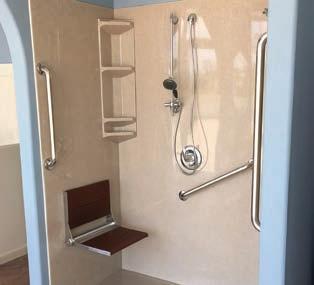


Texas food, music, housewares, gifts and more— find it all on our website, along with great deals for TCP readers.
Just pick and click—it’s easy to shop for friends and family without leaving home.
Target customers close to home with the North Texas advertising section of Texas Co-op Power. Be part of a statewide magazine without the statewide cost. Reach North Texas customers with Texas Co-op Power—a trustworthy name with affordable advertising options for regional and local businesses like yours.
Our North Texas advertising section targets homeowners living around Texas’ largest metropolitan area. With a regional circulation of 590,500 and a readership of 1,358,150, Texas Co-op Power delivers a huge audience that’s loyal and responsive.


DUE FEB 10 Family Vacation
DUE MAR 10 Catch of the Day
DUE APR 10 College Life
Enter online at TexasCoopPower.com/contests.
See Focus on Texas on our website for many more I Love photos from readers.
There’s a lot to love about Texas. From the diverse landscape to the fascinating wildlife, one can find beauty all around. But what makes it really special are the folks who call it home.
CURATED BY GRACE FULTZ
1 SHARON BURNS VICTORIA EC
A Texas sky captures the heart of a young boy.
2 ANGIE MANTOR BANDERA EC
“Weston, my grandson, and his sweet friend loving the beautiful weather at his home in Comfort.”
3 SHEILA HOWARD WHARTON COUNTY EC
“Love was definitely in the air at the Tejas Ranch Horse Show, not only between the friends participating but also the horses.”
4 PEGGY KUJAWA PEDERNALES EC
“When he found out it was too small to keep, he gave it a kiss before he released it.”



Setting a course for hope and serenity amid Alzheimer’s anguish
BY MARK TROTH ILLUSTRATION BY ROCCO BAVIERA
THERE WAS NO doubt that my friends, colleagues and family members had noticed a marked difference in me—yet they remained mostly silent, perhaps out of courtesy.
Repeating myself frequently in conversations, asking questions that had already been answered just minutes prior, frustrations with recalling people’s names and number sequences (phone, addresses, passwords)—all signals of early-onset dementia. Regardless of what was noticeable or not to others, I knew I was not the same.
I was referred to a neurologist who specializes in cognitive disorders and went through myriad memory-related tests in addition to MRI diagnostics. I’m 69 and over three years into the initial diagnosis of mild cognitive impairment,
confirmed as Alzheimer’s disease.
There have recently been exciting research breakthroughs on the Alzheimer’s front. Among them is a new drug being administered via infusion therapy. It has been proven in clinical trials to slow the disease’s decline by breaking up the protein amyloid plaque build-up in the nerve cells. That build-up is responsible for brain dysfunction.
It isn’t a cure but could add precious months of mental clarity to affected patients.
I was fortunate to qualify for the treatment after genetic testing and other requirements. My physicians, nurses and patient support group are a blessing to me and my wife.
Of course, as hopeful as I am for the potential to slow my cognitive decline and enjoy more quality time with my family, it is difficult to ignore the challenges they will soon endure.
I recently engaged a psychologist to help me cope better with the future. The initial sessions have proven highly educational and gratifying. I am positively in a better place now.
My doctor’s advice is both simple and profound. His leading and listening skills allow me to reach deeper within and come to a quiet peace with regards to my future.
My prior mindset had been: It’s the elephant in the room—heavy and ever present. But my doctor has me laser focused now on living for life and not for death.
Yes, I must surely take care of my family affairs so as to not place additional burden on my spouse and children. But most importantly my doctor implores me to strive for hope and peace of mind for whatever future I have.
Acceptance of this diagnosis and a renewed “living for life” mentality is my new North Star, guiding me home. Not so much for personal gratification but for serenity with my faith, family and friends. I have been blessed. D

















































